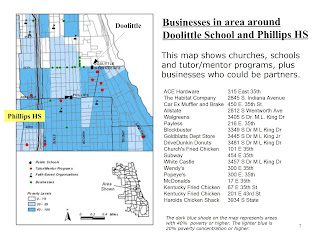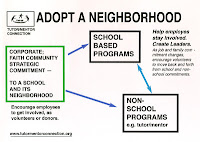We all want same outcomes. We want more youth to stay in school, be safe in non-school hours, graduate, and move on to 21st century jobs and careers.
This graphic is one of many that I’ve created to help communicate ideas and strategies. You can find more
here and in each blog article I’ve written since 2005.
If we do our work well, and for many years, we will have alumni providing their own testimonial to how a tutor/mentor program has helped them. This video is from a 2010 year-end celebration. The speaker first became involved with this organization in the early 1990s.
Year-End Dinner 2010: Tangela Marlowe from
Cabrini Connections on
Vimeo.
I created the Tutor/Mentor Connection in 1993 to help volunteer-based tutor/mentor programs grow in all high poverty areas of the Chicago region. I created the
Tutor/Mentor Institute, LLC in July 2011 to keep doing this work in Chicago and to help other cities apply these ideas.
I hope you’ll read the rest of this article and share my thinking with others.
If you’re a volunteer, investor, parent or donor, what indicators should we look for when we try to evaluate weather or not to become involved with a program? If you’re a community leader, how do we make sure enough programs are available in all of the places where they are needed?
To support the growth of tutor/mentor programs in many places I’ve created a
library of links to articles showing the challenges non profits face in offering long-term programs that reach youth early and stay with them through high school and even into college and adult lives.
One of the primary challenges volunteer-based tutor/mentor programs face is that most research and resources devoted to education is focused on what happens at schools during the 6-7 hours they are open every day for 9 months a year. This graphic illustrates a need to focus on building more mentor-rich youth supports in the non school hours, especially in neighborhoods of high poverty where too few of these resources exist.
I think we need to expand the number of people who are taking responsibility for youth growing up. This graphic illustrates the responsibility of the “
village” for helping kids through school and into jobs. Mobilizing the resources of the village and pointing them to schools AND non-school organizations in all high poverty neighborhoods represents a huge challenge.
I’ve spent the last 20 years looking for ways to overcome these challenges so that constantly improving tutoring/mentoring programs could reach youth in more places.
Part of my vision is to create an
adult education strategy that would reach people who don’t live in poverty, but who benefit, along with kids and families, from the work done by tutor/mentor programs. I’ve seen how effective marketing and advertising has created demand for fast food, internet services, PCs, ePhones and all sorts of consumer products.
How can we create the same customer support for non profits and social benefit organizations working with youth in high poverty areas of Chicago and other cities?
Can we educate donors, volunteers and parents to
look at a map of a city that shows where tutor/mentor programs are most needed as the first step in deciding what programs they want to help?
Once you pick a zip code and determine what programs are in that area, what do you need to see on the youth organization’s web site that indicates it has a vision and strategy that over time, and with consistent support from volunteers and donors, shows it can reach the result we all want?
I created this list several years ago. Do you agree with it? What would you add?
* Home page features "mentoring or tutoring" with headline words and/or pictures
* Home page has easy-to-find sub-feature of "mentoring or tutoring" with words and/or pictures
* Volunteer involvement opportunity is clear
* Contact information is clear so volunteer or donor can contact program
* Case made for why tutoring/mentoring is important
* Site shows role of tutoring/mentoring in workforce development
* Site shows benefit of volunteer involvement in tutoring/mentoring on the volunteer
* Site provides links to research related to tutoring, mentoring, poverty, education, etc.
* Site links to other tutor/mentor programs in the same city
* Site links to one or more Tutor/Mentor Connection web sites and/or Program Locator
We need many more people looking at this information and discussing these ideas. Where can we gather people who can help (resource providers, talent, media, political leaders, information organizers, facilitators, etc.) with people who need help (programs, clients) and with ideas (research, best practices, benchmarking) so we’re all connected to each other in ways that help youth organizations build and sustain the organizational strength needed to grow to be “great” organizations who can sustain youth/volunteer participation for as long as it takes to help the young person be out of school and in a job beyond poverty?
Furthermore, how can we expand this conversation to one where we’re trying to help all high poverty neighborhoods of a metropolitan region have “great” programs helping youth in each neighborhood work from birth to work?
And how do we sustain the flow of resources and talent to these programs in times when public attention is drawn to more high profile issues, such as elections, tsunamis, cyclones, hurricanes, earthquakes and war?
Each of the essays posted in the
Tutor/Mentor Institute, LLC library, the links in the Tutor/Mentor Library, and the articles in this blog are intended to be starting points and stimulants for discussions taking place in thousands of other places.
You can use these ideas where you are and I might never hear anything telling me that you have found this information useful.
But I hope some of my readers will join me in the
Tutor/Mentor Connection forum, on
Facebook, on
Linkedin, and on
Twitter to add your own ideas and vision or to help me develop and share these ideas with more people.
If you're in Chicago come to the Tutor/Mentor Leadership and Networking Conference on November 19 at the Metcalfe Federal Building and introduce yourself to me and others who will be attending the event. See
http://www.tutormentorconference.org.





















